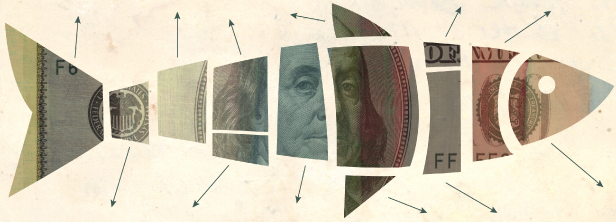More fish equaled more profit. In contrast, catch shares assign a secure piece (or share) of the pie (or total allowable catch) to each individual, cooperative, or fishing community. Fishers have time to choose when and how to fish; ideally in this model, profit comes by maximizing quality over quantity. Catch shares end the race to fish, allowing for a safer and potentially better managed fishery. But success depends upon how the pie is sliced and served up.
Challenges
Slicing the pie
When a catch share program is implemented, different methods can be used for determining the size of each share. Most often, catch shares are based on catch history, favoring those who had fished the hardest for the longest—not necessarily the most responsible or local fishers. In auctions, shares go to the highest bidder, which often shuts out small-boat fishers.
Sliver of a slice
Some shares are just too small to make a living, which forces fishers to sell their shares. That drives consolidation of a fishery into the few hands of big companies that own large vessels. These companies typically are not part of local communities, nor are they vested in the long-term stability of the fishery.
Linking recovery to catch shares
While catch shares may help stabilize the stock of a fishery, whether or not they help the biomass recover is unclear. The ultimate goal of catch shares, in theory, is to increase the size of the pie. But measuring this effect—and adjusting the new catch limits and catch shares accordingly—remains challenging.
Opportunities
Tying the resource to community
Effective and appropriate allocation of shares can determine the program’s success and acceptance. Creative financing by some cooperatives help small-scale fishers secure shares. Programs that restrict or limit the number of shares any individual can own prevent outside interests from dominating small, local fishers. Expanding these models, and developing new ones, offers fertile ground for social and economic innovation.
Time to think
In catch shares, fishers can grow their profits by fishing smarter, not harder. Given the time and incentive, some of these entrepreneurs are excellent innovators, designing better technologies and methods to increase the quality of their catch and to conserve the overall stock.
With privilege comes responsibility
Fishers are held accountable for their share of the catch. These programs often include greater monitoring and reporting efforts, with overall improved compliance with set quotas. This benefits the fishery and the consumer, with greater opportunities for improved traceability throughout the supply chain.





